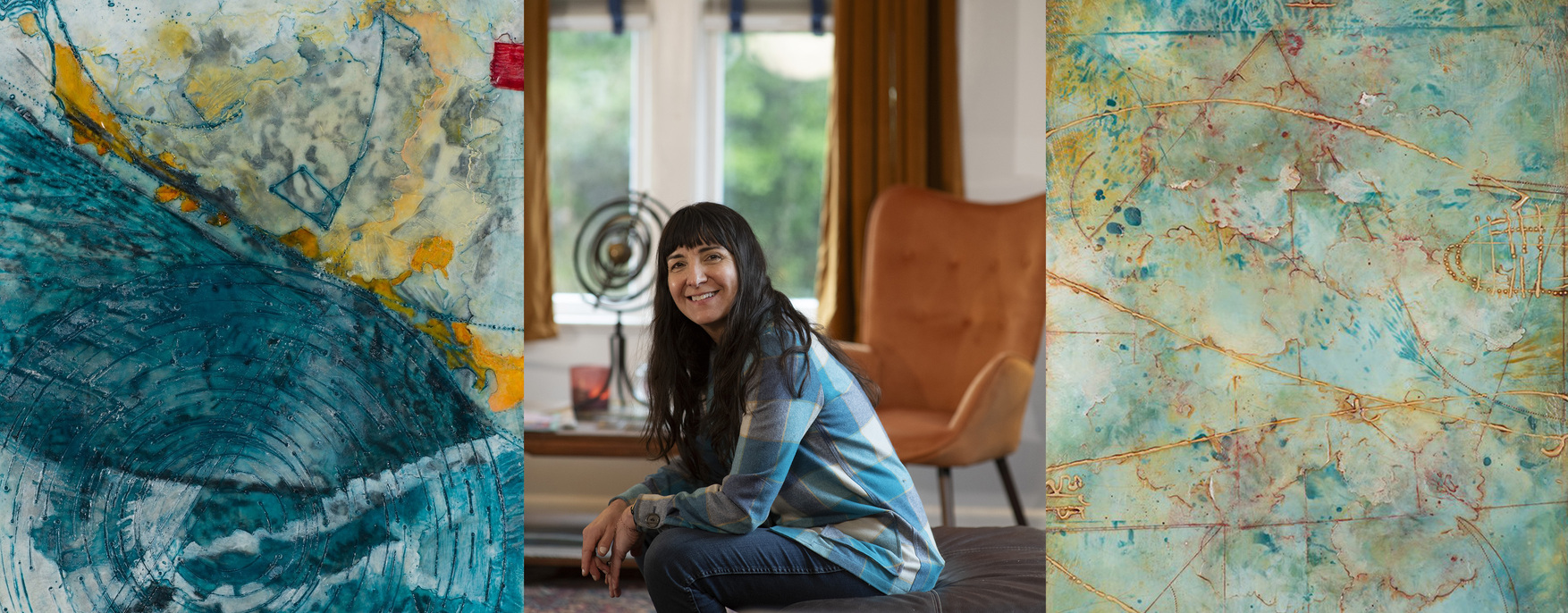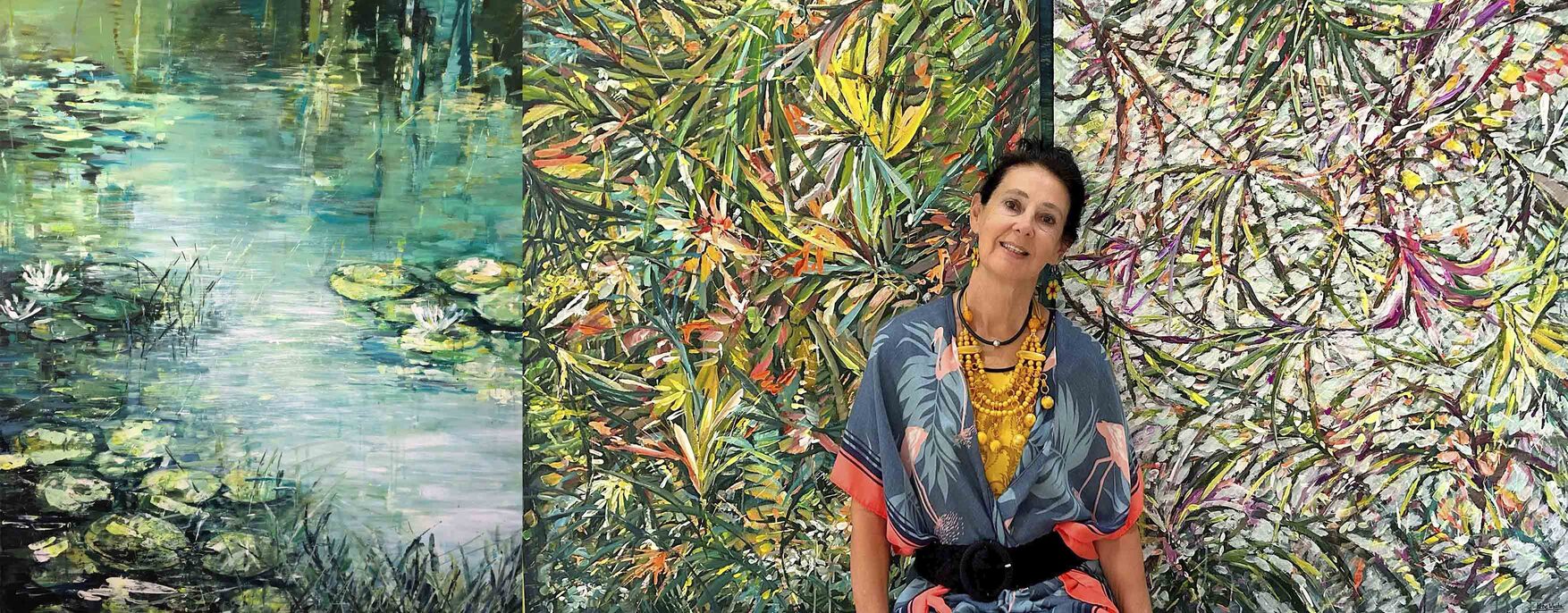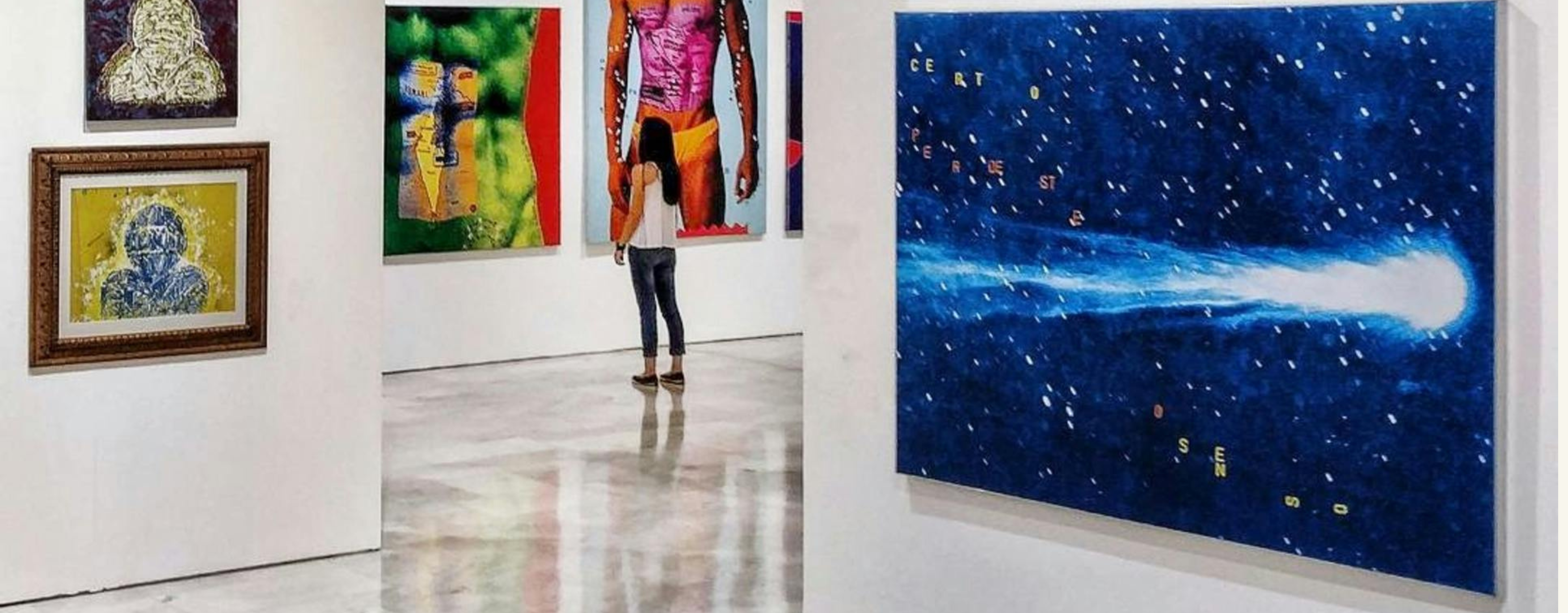Get to know artist Elise Wagner and learn how science and nature inspire her exploration of abstract art. Looking to reflect the beauty and fragility of the environment she sees, she takes her knowledge of cosmology and geology and expresses it through her skills with encaustic painting, a technique that mixes the use of beeswax, pigments and resin.
This interview is part of the upcoming “Bodies of Water” art exhibition, which will present diverse artworks focused on water, its symbolism, and its environmental significance. Curated by Sergio Gomez and Didi Menendez, the show will be held from November 7 to December 27, 2024, at 33 Contemporary Gallery in the Palm Beach Art & Design Showroom. It will also be accessible through a 3D online art show powered by ArtPlacer.
Read on to discover more about Elise’s work.
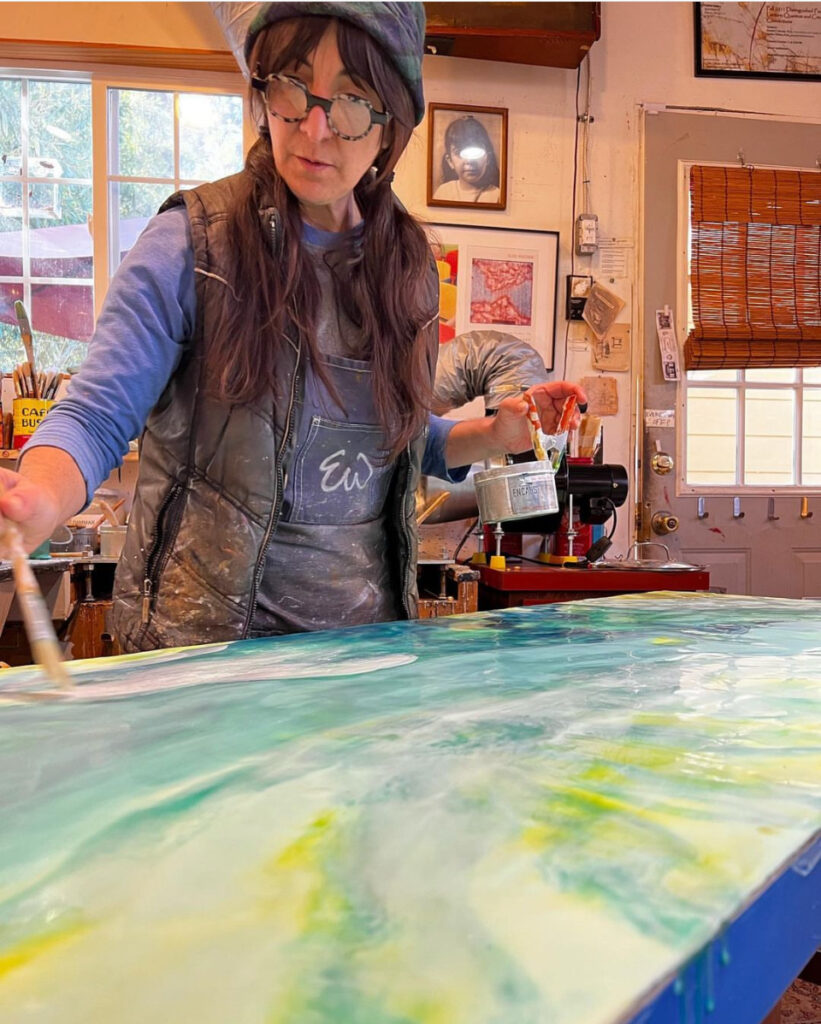
Elise Wagner working on her studio in one of her encaustic painting pieces.
Tell us a little about your background as an artist. How did your journey as an artist begin, and what inspired you to pursue a creative career?
My journey as an artist began from the trauma of a serious car accident in 1982, where I suffered face, neck, and knee injuries. As an aspiring dancer whose dreams were cut short, I turned to art in my recovery. Growing up, I was always drawn to art, photography, architecture, school science fairs, and watching NOVA on public television. I always had a natural fascination with nature’s beauty and the mysteries of the universe. That mix of interests really laid the foundation for my work, where I aim to explore themes that connect scientific concepts and earth’s elements through visual expression.
I formally began studying art in my teens, with a focus on painting and printmaking, and eventually discovered encaustic painting. The wax medium that combines beeswax with
pigment and resin felt like the perfect match for my artistic vision—it allows me to create layers of depth and transparency, almost like uncovering geological or cosmic maps. This technique has been my primary medium, and it’s given me a way to really dig into ideas that might seem abstract or complex in a scientific sense and translate them into something tangible and visual.
Pursuing a creative career felt natural because, for me, art is about exploration. I wanted to build a bridge between the analytical and the aesthetic, to visually interpret scientific
phenomena in a way that invites people to see things differently. Whether it’s through mapping patterns or capturing a cosmic moment, my work is all about bringing the invisible to the visible and sparking curiosity in those who experience it. What better way to do it than with layers of natural beeswax?!
Your artwork is featured in the ‘Bodies of Water’ exhibition. Can you share the story behind the piece you submitted? What themes does your work explore?
In the Bodies of Water exhibition, my work delves into the interconnectedness of water systems, earth, and human impact, emphasizing themes of flow, transformation, and resilience. I recently relocated to the Northern Coastal town of Astoria, Oregon, which lies at the confluence of the Mighty Columbia River and the Pacific Ocean and is one of the most
dangerous and active waterways in the world. The piece I submitted draws upon how stars and planets influence the tides, natural cycles and movements within bodies of water. I wanted to incorporate my new surroundings by exploring how such confluences of water mirror both the fragility and strength of nature.
The encaustic process, both fragile and durable itself, allows me to layer colors and textures, creating a sense of depth that reflects water’s translucent quality and constant motion.
Painting with molten wax and the fire of a blow torch offers the ability for me to create, paradoxically, imagery reminiscent of the elements from the flow of rivers to waves of oceans and the melting of ice. Through the abstraction of what I see in nature, I aim to evoke the complexity of water’s role in our ecosystem and the profound effect climate change has on these essential systems.
A view into the top 5 selection of artworks from the “Bodies of Water” exhibition.
Can you walk us through your creative process, from the initial concept to the final piece?
My creative process begins with inspiration from scientific imagery, the natural landscapes I explore in my environment, and abstract concepts related to structure and transformation. I usually start by gathering visual references from aerial and drone photography that particularly focuses on geologic patterns, textures, and shapes that align with my vision for the piece. I also draw upon photos I take for additional color studies and compositions.
Once I have a concept in mind, I think about how it can be expressed through layers of pigmented wax, which offers unique possibilities for depth, translucency and movement.
Working with encaustic requires a lot of preparation; I melt beeswax on a hot plate and mix it with pigment to create foundational colors and various hues. I then apply these layers onto a wood panel, building up transparent and opaque areas to achieve a sense of dimensionality.
Each layer is fused with heat from a heat gun, propane blow torch or iron, each creating flatness or texture that reveals unexpected details. The process of adding, removing, and reshaping these layers is essential to the final result. It’s a balance between control and spontaneity that I negotiate with the piece to bring it to conclusion.
Creating is like a conversation, I will say something with a mark then, the painting will say something back, I respond and a narrative begins which is what I love most about this medium and being an abstract painter in general.
Throughout the process, I refine the piece by adding grid patterns, organic shapes, marks, symbols, legends and other details that suggest maps, exploring and scientific themes. The final piece emerges as I layer these elements to create a composition that feels both abstract and rooted in the natural world. It’s a journey that’s both intuitive and deliberate, a way of capturing the complexity of our surroundings in a single, cohesive form.
How do your experiences and surroundings influence your work? How does your identity or background play a role in your creations?
In many ways, my experiences and surroundings are deeply woven into my work. Growing up in a densely urban environment on the Hudson River and traversing New York City with my father exposed me to structure early on which resulted in a deep interest in architecture.
Moving to the Pacific Northwest from Jersey City, New Jersey, I was awestruck by the majestic and untouched wilderness of this region.
My love of structure, architecture, and a natural curiosity for the sciences was met with a new love for the outdoors and nature as I grew into adulthood. Through the study of geology in college, I learned how geological layers tell the story of time throughout the world. That fascination with both art, science and geology became a cornerstone of my identity and continues to shape my creative process.
My background as an artist and my ongoing study of contemporary discoveries in astronomy, geology, and cosmology have been instrumental in how I approach my work. I see art as a way to bring these abstract, often invisible forces into view, inviting others to explore them with me.
For example, the textures, layers, and translucency I create with encaustic wax echo geological formations and cosmic depths that I see in nature, almost like peering into a landscape that’s both familiar and mysterious, the very definition of science itself.
In a larger sense, I think my identity as someone who straddles the worlds of art and science, gives my work a sense of duality—a way to merge the analytical with the intuitive.
This combination allows me to communicate my own perspective and curiosity, inviting others to see the world through my lens, where beauty and complexity are always connected.
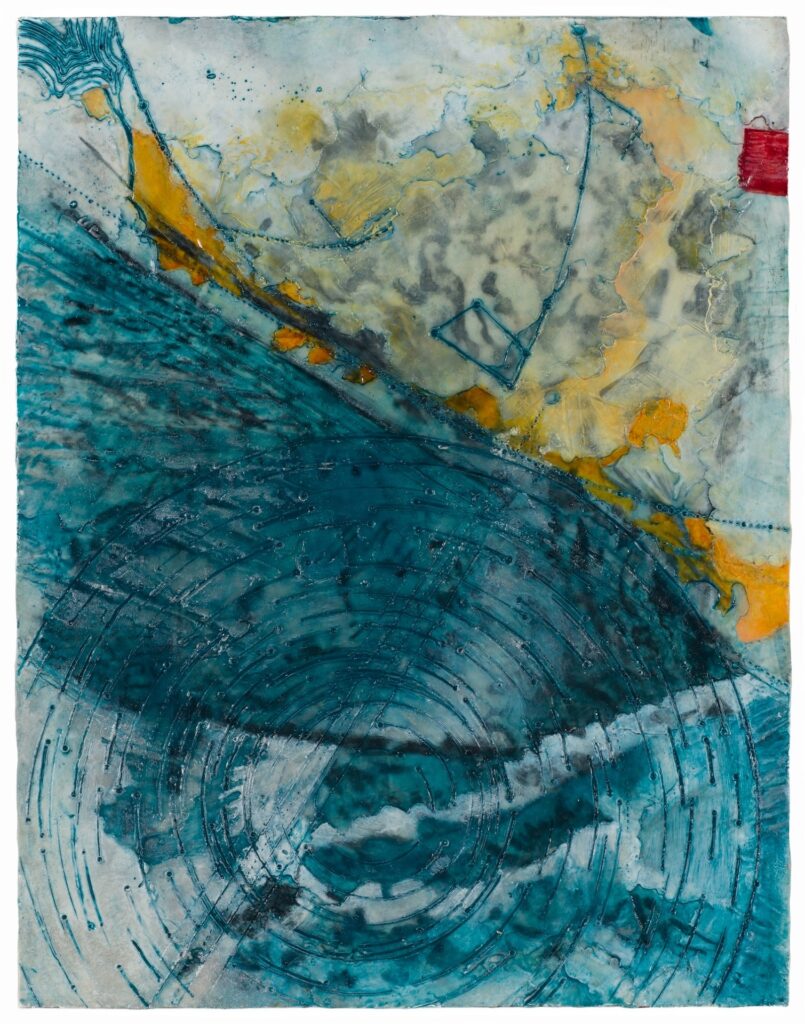
A look into “Star Trails”, the piece Wagner will present at the “Bodies of Water” exhibition.
Water is such a powerful symbol—what does it represent in your work? How do you connect with the exhibition’s theme, and what unique perspective do you bring to it?
In my work, water symbolizes both life’s fluidity and resilience, as well as its vulnerability in the face of environmental changes. Water, to me, represents a continual cycle of renewal and transformation, mirroring the forces that shape our planet and our lives. It’s an element that both sustains and erodes, carrying with it stories of time and movement.
In connecting with the Bodies of Water exhibition theme, I explore water as a reminder of our interconnectedness with nature. I try to bring a perspective that not only appreciates water’s aesthetic beauty but also underscores its critical role in sustaining life. Through the encaustic process, with its layers and fluidity, I aim to evoke water’s textures and shifting forms, blending scientific influences with abstract art to capture the essence of flowing rivers, eroding coastlines, or microscopic structures within water itself.
My perspective brings an intersection of art and science, highlighting how water connects ecosystems and shapes the earth. It’s a celebration of water’s transformative power but also a reflection on its fragility, urging viewers to consider how deeply tied we are to its future.
What do you want people to feel or take away when they view your work?
When people view my work, I want them to feel a sense of awe and connection to the natural world, especially the intricate systems that sustain life but often go unnoticed. I hope to evoke curiosity about the delicate balance within our environment and how interconnected we are with it. Through the layered textures and abstract forms, I aim to offer a space for reflection on both the beauty and fragility of nature, inspiring a deeper appreciation for elements like water, earth, and the unseen forces that shape our world.
Ultimately, I want viewers to leave with a renewed awareness of their place within the greater ecosystem and a sense of responsibility to protect these natural resources. My work is a visual reminder that we are part of a larger, intricate web—and that each of us plays a role in its preservation.
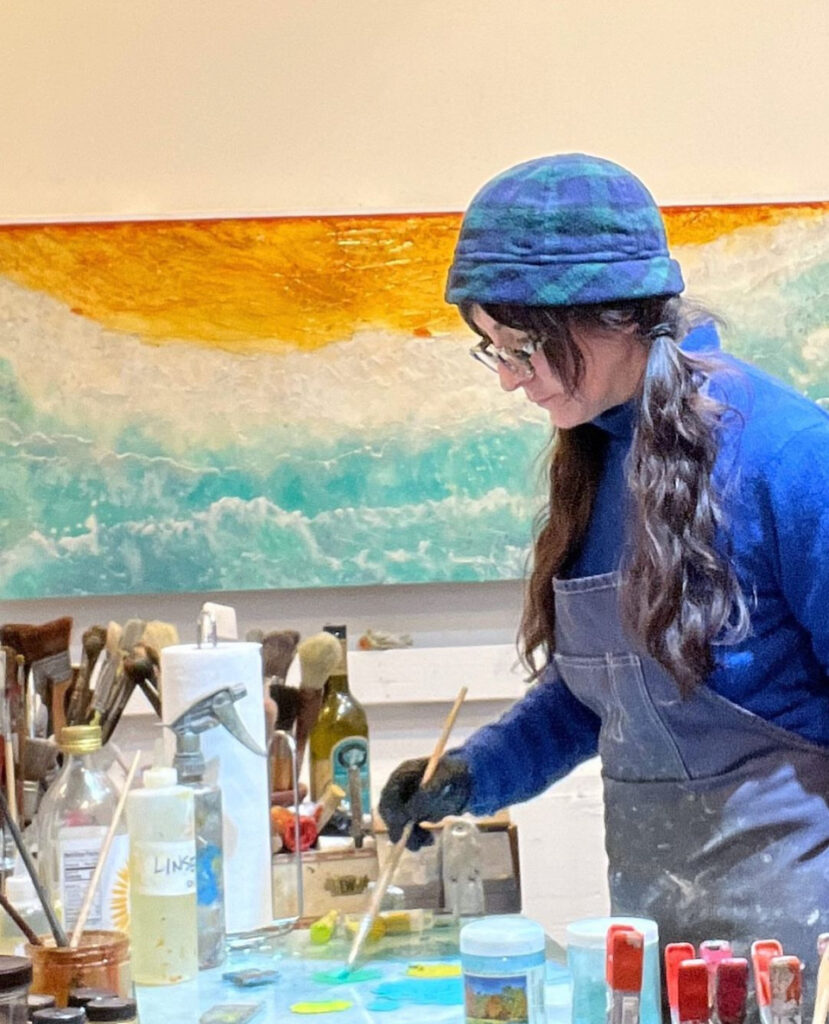
Wagner gets inspiration from cosmology, geology and a mix of science and nature.
Building an online presence has become essential for artists in today’s digital age. How do you use social media and art marketing tools to connect with your audience and promote your work?
In today’s digital landscape, social media has become a vital tool for me to connect with a broader audience and share my creative journey. Platforms like Instagram allow me to showcase my work, share behind-the-scenes insights into my unique process, and offer more depth into my inspirations, which helps build a personal connection with viewers. By sharing short videos, close-ups of textures, and snapshots of my studio, I invite people into the world of encaustic art, making the medium more accessible and engaging.
I also use art marketing tools like newsletters, a blog, and my website to keep my audience informed about upcoming exhibitions, workshops, and new pieces. My website acts as a portfolio, giving collectors, galleries, and art enthusiasts a comprehensive look at my work and career.
Additionally, newsletters allow me to share more in-depth stories and updates with my dedicated followers, creating a sense of community. Using a member portal on my website has been a way to connect with my audience in a special way offering exclusive content.
Through these digital channels, I aim to reach both seasoned collectors and those new to art, creating a dialogue around my work and the themes I explore. The online space allows me to foster meaningful connections and extend my work’s impact beyond gallery walls, making art accessible and relatable on a global scale.
What role do exhibitions like ‘Bodies of Water’ that are both physical and digital play in an artist’s career?
Exhibitions like Bodies of Water, which bridge both physical and digital realms, are incredibly valuable in an artist’s career. They provide a platform for reaching diverse audiences—those who can experience the work in person and those who can connect with it online from anywhere in the world. This dual presence greatly enhances visibility and allows for a wider impact, which is crucial in today’s interconnected art world.
Physically, exhibitions offer a tangible, immersive experience where viewers can fully appreciate the textures, scale, and subtle details of a piece, especially with a tactile medium like encaustic.
Being able to see a work in person often evokes a stronger emotional response, allowing audiences to engage with the art on a deeper level. It’s also a space where artists can interact with their viewers, creating personal connections and fostering conversations around the themes of the exhibition.
Digitally, these exhibitions expand access, allowing people who may not be able to visit in person to still engage with the work. The online component enables a lasting presence; long after the physical show is over, images, videos, and virtual tours continue to share the work with a global audience. This is invaluable for building an ongoing connection with collectors,
curators, and art enthusiasts, and it extends the life and reach of the exhibition. Ultimately, hybrid exhibitions are powerful for both visibility and connection, blending the irreplaceable experience of viewing art in person with the accessibility and reach of the digital world. They allow artists to grow their audience, connect with people in meaningful ways, and make their work accessible to a broader spectrum of viewers.
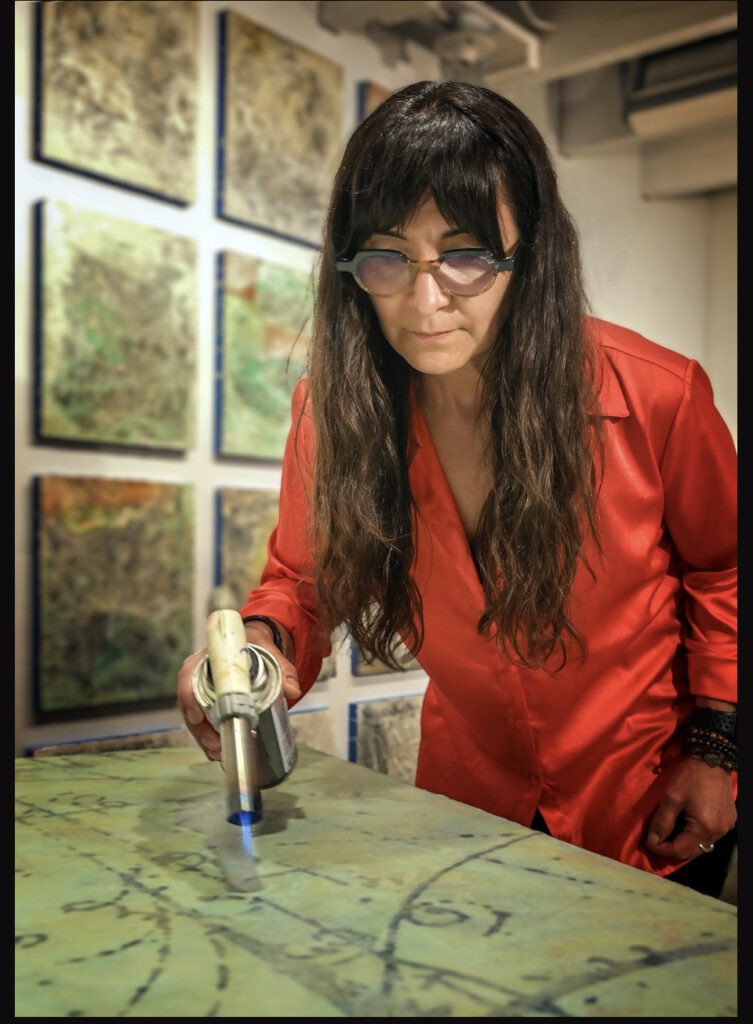
Wagner works with encaustic painting, which involves working with wax, resin, and pigments as mediums.
How has participating in this exhibition impacted you?
The piece chosen for my participation in Bodies of Water “Star Trails”, was part of my recent solo exhibition entitled “Wonder Lands” which focused on bodies of water and was a love letter to the Pacific Northwest. This opportunity has given me a platform to share the theme of water specific to my region of the world in a place it would never have been seen.
Additionally, it has given all of the artists in the show an opportunity to share the significance of water as a vital element that connects us all. The exhibition has pushed me to think more critically about how I convey these natural elements and their ecological importance, inspiring me to expand on these themes in new and meaningful ways.
Sharing space with other artists who also engage with the concept of water has been incredibly enriching. It’s a unique experience to see diverse interpretations of the same theme, which has broadened my perspective and challenged me to think differently about my own work. This collaborative environment fosters a sense of community and shared purpose that feels particularly meaningful, especially around an element as universal as water.
The hybrid nature of the exhibition, with both physical and digital components, has allowed me to connect with a wider audience than I would have otherwise. I’m grateful for the chance to reach people who may not have experienced my work in person, as the digital platform extends the conversation and impact of the exhibition.
Overall, participating in Bodies of Water has deepened my connection to my work, expanded my reach, and renewed my commitment to using art as a tool for environmental awareness and connection.
What advice would you give aspiring artists just starting their journey?
My advice to aspiring artists is the same as the advice I have always given to myself; stay curious, trust your intuition, be true to yourself no matter what and embrace the journey. Art is about exploration, so let yourself experiment and play without worrying too much about perfection. Don’t be afraid to take risks and try new techniques; that’s often when the best things happen.
Developing a daily practice, no matter how small, is also essential. The more time you spend creating, the more you’ll learn about your interests, strengths, and the direction you want your work to go. Over time, you’ll start to notice the themes and styles that resonate with you, and those become the foundation of your artistic identity.
Surround yourself with a supportive community of like-minded individuals, whether online or in person. Connect with other artists, attend exhibitions, join workshops, and don’t hesitate to reach out to artists you admire. This network can be a source of inspiration, motivation, and growth, especially when challenges arise.
Lastly, remember that every artist’s journey is unique. Success isn’t always a straight path, and it’s important to stay true to yourself and your vision. Be patient, trust your process, and keep creating work that feels authentic to you. Art, just like life, is a long, evolving journey—embrace it, stay open to change, and let your passion guide you forward.
Editor’s note: this interview was edited for length and clarity.
